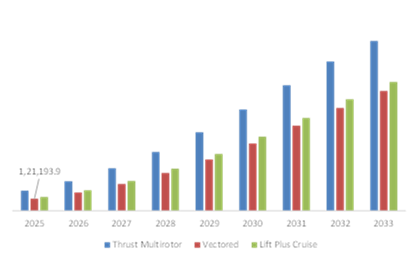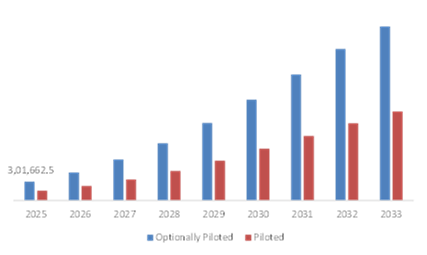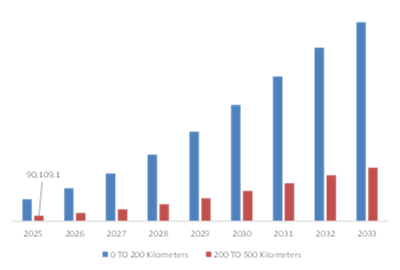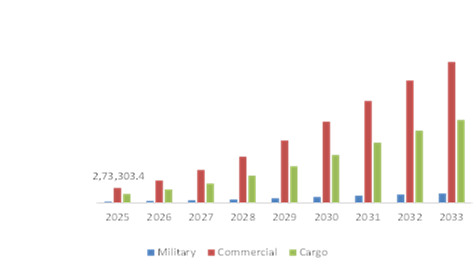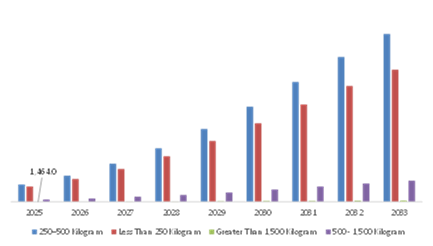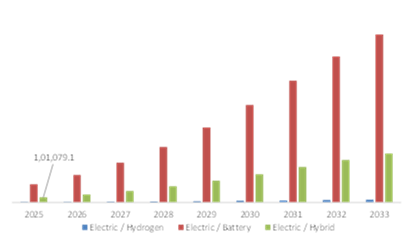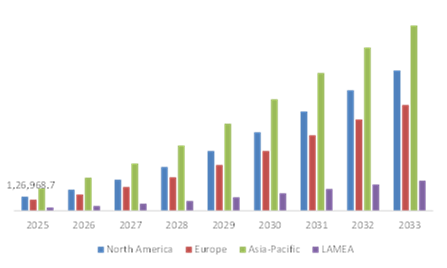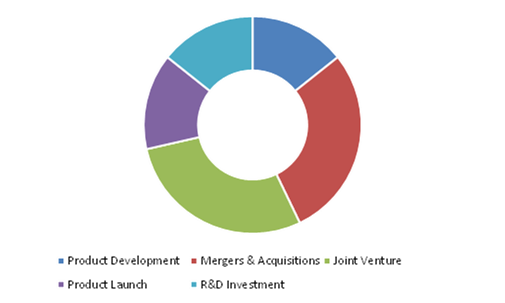EVTOL Aircraft Market Report
RA00166
EVTOL Aircraft Market, by Lift Technology (Thrust Multirotor, Vectored, Lift Plus Cruise), Operation (Optionally Piloted, Piloted), Range (0 to 200 Kilometers, 200 to 500 Kilometers), Application (Military, Commercial, Cargo) Maximum Takeoff Weight (250–500 Kilograms, Less than 250 Kilograms, Greater than 1,500 /Kilograms, 500-1,500 Kilograms) Propulsion (Electric/Hydrogen, Electric/Battery, Electric/Hybrid), Regional Analysis (North America, Europe, Asia-Pacific, LAMEA): Global Opportunity Analysis and Industry Forecast, 2026-2033
The global eVTOL aircraft market forecast shall be $4,222.4 million by 2033, increasing from $458.0 million in 2025 at a healthy rate of 29.6%. The North America eVTOL aircraft market is estimated to grow at a CAGR of 31.1% by registering a revenue of $1,283.6 million, throughout the analysis period. Strategic collaborations among the market players along with the launching of advanced eVTOL aircraft services are expected to accelerate the North America eVTOL aircraft market growth.
eVTOL Aircraft Market Analysis:
eVTOL, electric vertical takeoff and landing, is a type of aircraft that uses electrical propulsion to takeoff, hover, and land vertically. They are designed for urban air mobility, cargo deliveries, and Military Survelliance.
Impact Analysis of COVID-19 on the eVTOL Aircraft Market
The global eVTOL aircraft market is predicted to witness a significant growth during the outbreak of the COVID-19 pandemic, owing to the disruption of supply chain, which causes delaying in the projects of eVTOL aircrafts. The eVTOL aircraft market is in early stage of development and it is expected to commercialized in 2025. Several companies operating in the eVTOL aircraft industry such as Ehang and Airbus are coming forward with their strategic steps to help society during the COVID-19 chaotic situation. For instance, leading eVTOL aircraft companies such as EHang have come forward to help china in mitigating the covid outbreak by providing medical supplies to local hospitals with the help of eVTOL drones in 4km range ; all these factors are expected to drive the growth in the forecast period and new developments in upcoming years.
However, most of the companies are working on sustainable prototypes for the development of eVTOL aircrafts. For instance, on 20 August 2020, Urban Aeronautics, Israel-based aircraft manufacturer, announced its partnership with U.S.-based Hatzolah Air for manufacturing of that is used as air ambulance. The Cityhawk VTOL is planned to be hydrogen power aircraft without rotors or wings, therefore it can both fly and land according to use. Moreover, on September 25, 2020, announced that Japan Airlines (J.A.L.) signed a bond with Matternet to produce drones to provide healthcare deliveries for future opportunities. This demand for eVTOL aircraft is projected to grow in the fourth quarter of 2020 despite the ongoing coronavirus crisis. These key factors may generate investment opportunities for the eVTOL aircraft.
Increasing traffic congestion has fueled demand for alternative ways of traveling which may generate remarkable revenue for the global eVTOL aircraft market
The eVTOL aircraft industry will be witnessing massive growth mainly because of the increase in the global urban population followed by the traffic congestion. According to the United Nations, in 2018, around 55% of the world's population lived in urban areas and is expected to increase to 68% by 2050. Therefore, demand for efficient and effective mobility in urban areas is a crucial challenge. There are many companies and municipal corporations currently working on eVTOL aircraft manufacturing for air mobility solutions. For instance, Japan's SkyDrive and Volocopter plans to commercialize eVTOL in Japan by 2023. Also, the companies such as Bell Textron, in February 2020 announced that they are partnering with Japan Airlines and Sumitomo Corporation to explore the development of an on-demand air mobility ecosystem in Japan using Bell's Nexus 4EX eVTOL air taxi. These advancements may lead to an increase in the demand for eVTOL aircraft services in the global market.
To know more about eVTOl aircraft market drivers, get in touch with our analysts here.
https://www.researchdive.com/connect-to-analyst/166
A higher initial investment may restrain the growth of the global eVTOL industry
The notable key factor that can restrain the market of eVTOL aircraft globally is the higher cost investment in infrastructure and research and development and lack of 5G infrastructure across the globe. Moreover, the acceptance of eVTOL aircrafts in terms of safety and security by the public is expected to create a negative impact on the eVTOL aircraft market during the forecast period.
The growing need for emergency ambulance may create huge opportunities for the global eVTOl aircraft market in the future
The eVTOL aircraft industry is expected to grow at a fast pace due to rise in urban population and demand for air mobility in medical emergencies. Also, according to the National Academy of Engineering, in 2017, 20% of emergency patients' deaths were caused by traffic jams. Due to increase in vehicular traffic and congestion, it is very difficult for ambulances to reach on time. eVTOL aircrafts provide an opportunity for the shorter ambulance response time. For instance, in February 2020, the Chinese autonomous aerial vehicle (AAV) developer, EHang successfully used eVTOL as ambulances during the catastrophic Coronavirus outbreak. Furthermore, eVTOLS have potential use in natural disaster relief in times such as wildfires, flood, and storms. Moreover, the lower noise signature and inherent electric efficiency make them excellent for hospital use. In addition, the eruption of disease outbreaks worldwide along with an increasing acceptance of electric VTOL aircraft for emergency medical services (EMS) is one of the significant factors for the growth of eVTOL aircraft market during the projected period.
To know more about eVTOL aircraft Market Opportunities, get in touch with our analysts here.
https://www.researchdive.com/connect-to-analyst/166
EVTOL aircraft Market, by Technology Type:
The vectored technology will generate a revenue of $121.1 million by 2033, mainly because of its enhanced flexibility for the military and security missions
Source: Research Dive Analysis
The global eVTOL aircraft market on the basis of technology is segmented into thrust multirotor, vectored and lift plus cruises technology. Vectored technology is expected to expirence fastest growth and it is anticipated to generate a revenue of $1,208.5 million by 2033, growing from $121.1 million in 2025. The growth of the vectored sub-segment is mainly attributed to its unmanned aerial technology, its data link and most importantly autopilot feature. Moreover, this whole system can be transported by a single person and recognized as the perfect option to maintain height during flight transitions. Vectored eVTOL aircrafts are mainly developed for military and security missions, owing to their application to control angular velocity. These key factors are expected to boost the demand for eVTOL aircraft in the global market during the projected period owever, thrust multirotor type shall have a dominating market share in the global market and is expected to register a revenue of $1,715.1 million, during the analysis timeframe. Owing to its major advantages in eVTOL aircrafts . Thrust multirotor in aircraft can drive the propeller reliably and with high acceleration, so the speed can be changed quickly. [PP7] [SP8] Moreover, the large number of multi rotors in aircrafts operate the low tip speeds which results in low noise comparative to an aircraft with less rotors. For instance, in C.E.S. 2019, Bell Textron Inc., a leading player in eVTOL vehicles, has introduced the novel idea of electric-powered, high-tech, mega-multirotor eVTOL. This eVTOL, named 'Bell Nexus,' is built with a hybrid-electric propulsion system featured with 'Bell’s signature powered lift concept’ for more safe and efficient air travel. These initiatives may create massive opportunities for the sub-segment throughout the forecast period.
EVTOL Aircraft Market, by Mode of Operation:
The global optionally piloted segment for eVTOL aircraft market will have the highest market share; this is mainly because of its low-noise aircraft configuration
Source: Research Dive Analysis
The optionally piloted sub-segment of the eVTOL aircraft market will have the fastest growth and it is projected to surpass $2,792.6 million by 2033, with an increase from $301.6 million in 2025; this is mainly owing to continuous advancements in the unmanned aerial technologies for faster and safe delivery and transport services driving the demand for optionally piloted eVTOL aircraft.
EVTOL Aircraft Market, by Range:
200 to 500 Kilometers range sub-segment will have significant growth in the global market; this is mainly because of the reduction in the traveling time between the cities
Source: Research Dive Analysis
The 200 to 500 kilometers sub-segments for eVTOL aircraft market shall have rapid growth and it is anticipated to generate a revenue of $892.2 million by 2033. With the help of eVTOL technology, the passengers can travel at a lesser time as it can take off and land almost anywhere and are more flexible than conventional planes. On the other hand, Nasa has developed the battery-powered GL-10 hybrid diesel-electric tilt-wing aircraft, which can take off and land vertically and fly efficiently like a conventional plane, which is predicted to create more opportunity for the sub-segment market in the estimated period.
Moreover, the 0 to 200 Kilometers shall have a dominating market share in the global market and is expected to register a revenue of $3,330.1 million during the analysis timeframe. The growth of sub segment is owing to increasing demand for short-range aircraft as it can offer major benefits such as flexibility, lesser air pollution, smooth operations and fast travel. For instance, WatFly, the Canadian startup, on October 2, 2020, developed single seat eVTOL aircraft featured with 4-rotor manned multicopter; the maximum speed is 200 km, and it is FAA certified. The WatFly will be commercialized by 2021, which might open up new opportunities in the forecast period.
EVTOL Aircraft Market, by Application
The commercial sub-segment will have significant and fastest growth in the global market; this is mainly because of its larger applications in air transport
Source: Research Dive Analysis
The commercial application shall have fastest growth and this sub-segment is anticipated to generate a revenue of $2,548.8 million by 2033, during the forecast period. The commercial applications for eVTOL aircraft in urban air mobility will experience robust growth due to its safe transportation mode. For instance, Bell Textron signed a bond with a uber elevate partner for developing eVTOL aircraft with multiple applications, including urban air taxis, and it will be commercialized by 2024. Moreover, Volocopter on 21 August 2019 launched the first commercial volocopter aircraft, and it is designed to meet all the safety standard measures approved by European Aviation Safety Agency. All these factors will positively affect the sub-segment growth during the forecast period.
EVTOL Aircraft Market, by Payload
The greater than 1,500 Kilogram sub-segment will have fastest growth in the global market due to rising military and air ambulance application
Source: Research Dive Analysis
The greater than 1,500 Kilogram for eVTOL aircraft market shall have fastest growth and it is anticipated to generate a revenue of $17.1 million by 2033, during the forecast period. It can be on high demand due to rising military and air ambulance application and also it is widely used as drones for delivering medicines and other necessities, but it can also be used in many kind of natural disaster to transport necessities and work as an air ambulance to travel fast for ill patients. which is predicted to create lucrative opportunities for the eVTOL aircraft market in the forecast period.
The 250–500 Kilogram sub-segment for the eVTOL aircraft market shall have significant growth and it is anticipated to generate a revenue of $2,197.9 million by 2033, during the forecast period. These eVTOL aircrafts are highly suitable for passenger and cargo transport purposes. For instance, Boeing, an American multinational corporation, is working on drone that can carry 500 pounds of weight, featuring eight rotors with a vertical landing. Moreover, EmbraerX and Elroy Air, on 8 January 2020, announced their partnership for developing drones that can deliver up to 250 kg of weight. All these factor increase the demand for the 250-500 kg evtol aircrafts during the forecast period These key factors may enhance the sub-segment growth.
EVTOL Aircraft Market, by Propulsion
Electric/hybrid sub-segment will have the fastest growth in the global market due to rising demand for electrical infrastructure
Source: Research Dive Analysis
Electric/hybrid sub-segment may experience fastest growth during the forecast period with a revenue of $941.1 million and a CAGR of 29.8% due to its benefit of providing sufficient power during operational conditions, which plays a vital role in manufacturing eco-friendly aircraft as they do not cause any negative impact on environment by releasing harmful gases. Also, technology inventions led the development of more innovated eVTOLs that are highly efficient. For instance, in 2019, Safran, a global leader in turbine engine manufacturing, made a strategic collaboration with Bell, a leading company in the aerospace industry, to design and develop the most innovative aircraft hybrid-electric propulsion systems. Through this collaboration, Safran aimed to find a new solution for designing lightweight and safe aircrafts like air taxis to serve their customers with faster delivery services and better safety.
However, electric/battery sub-segment of eVTOL aircraft market will have the fastest growth and it is projected to surpass $3,230.5 million by 2033, with an increase from $350.9 million in 2025; this is mainly owing to rising demand of eVTOL aircraft that can propel by batteries so it can run on a single charge. Moreover, manufacturers in battery technology working on this and trying to manufacture low weight batteries which will reduce the aircraft weight, all this factors is expected to propel the growth of the market in the analysis period.
Regional Insights:
North America region has a lucrative market and it will reach up to $30,529.5 million by the end of 2027 mainly because of the presence of industry players and their heavy investments to enhance the safety & convenience of customers in eVTOL aircrafts
Source: Research Dive Analysis
The North America eVTOL aircraft market accounted for $126.9 million in 2025 and is projected to register a revenue of $1,283.6 million by 2033. The extensive growth of the North America eVTOL aircraft market is mainly driven by key factors such as heavy investments by market players along with the adoption of advanced technologies towards the air mobility solutions will expected to boost the North America eVTOL aircraft market. Also, massive support of government in eVTOL aircraft production is also likely to bolster the demand for eVTOL aircrafts. For instance, in 2018, US Army signed a bond with Uber Technologies, Inc. for the production of military eVTOL aircrafts for various benefits of eVTOL aircraft. The government initiatives and the companies investing across the region are predicted to positively drive the demand for eVTOL aircraft in the region and during the analysis period.
Asia-Pacific eVTOL aircraft market share is projected to grow at a CAGR of 28.0% by registering revenue of $1,697.4 million by 2033. Extensively increasing road traffic congestion in urban areas and demand for fast transportation and also rising investments in the R&D sector and growing emphasis on the enhancement of air mobility are expected to drive the Asia-Pacific eVTOL aircraft market over the forecast years. Furthermore, leading players operating in the eVTOL aircraft market are opting for various effective strategies such as strategic alliances, launching of value-added products/services, and business expansion to strengthen market position in the global industry. For instance, June 25, 2019, Boeing announces that are in a partnership with Kitty Hawk which is called Wisk. The company is focusing on the Kitty Hawk’s electric Cora aircraft with capacity of two people and till now they have completed more than 1000 test flights and it is expected that it will be commercialized in upcoming years. These type of key factors are expected to propel the growth of the market, over the forecast period.
Competitive Scenario in the Global eVTOL Aircraft Market:
The advanced product development coupled with mergers & acquisitions are the frequent strategies followed by the significant market players
Source: Research Dive Analysis
Some of the leading eVTOL aircraft market players include eHang, Lilium GmbH, Airbus S.A.S., Aurora Flight Sciences, Bell Textron Inc.,Volocopter GmbH, Workhorse, Karem Aircraft, Inc Kitty Hawk, Pipistrel D.O.O. eVTOL aircraft market players are focusing on Merger & acquisition and advanced product developments. These are the effective strategies followed by the startup as well as established organizations.
Porter’s Five Forces Analysis for eVTOL Aircraft Market:
- Bargaining Power of Suppliers: The eVTOl aircraft service suppliers are high in number, and are much more larger and globalized. So, there will be less threat from the supplier. Thus, the bargaining power of the supplier is High
- Bargaining Power of Buyer: Buyers will have moderate bargaining power, significantly because of multiple players operating in the eVTOL aircraft services. The eVTOl aircraft service provider offers multiple eVTOLs with popular brands at an affordable price. The buyers can freely choose the convenient service that best fits their preferences. Thus, the bargaining power of the buyer is Moderate
- Threat of New Entrants: The companies entering into the eVTOL aircraft market are adopting technological innovations such as developing integrated services to attract customers. Also, these companies are implementing various effective strategies and also there is government support in some countries. Thus, threat of the new entrant is High
- Threat of Substitutes: Customer preference and several substitutes are available in this market such as other air mobility services. Therefore such alternative options can’t offer the kind of accessibility and convenience that a eVTOL aircraft does. Thus, the threat of substitutes is Low
- Competitive Rivalry in the Market: The competitive rivalry among the industry leaders is rather intense, especially between the global players including eHang, Lilium GmbH and Airbus S.A.S.,. These companies are launching their value-added services in the international market and strengthening the footprint worldwide. Therefore, the Competitive Rivalry in the Market is High
| Aspect | Particulars |
| Historical Market Estimations | 2018-2019 |
| Base Year for Market Estimation | 2019 |
| Forecast timeline for Market Projection | 2025-2033 |
| Geographical Scope | North America, Europe, Asia-Pacific, LAMEA |
| Segmentation by Technology |
|
| Segmentation by Mode of Operation |
|
| Segmentation by Range |
|
| Segmentation by Application |
|
| Segmentation by Payload |
|
| Segmentation by Propulsion |
|
| Key Countries Covered | U.S., Canada, Mexico, Germany, France, UK, Italy, Spain, Russia, Rest of Europe, China, Japan, India, Australia, South Korea, Rest of Asia-Pacific, Brazil, Saudi Arabia, United Arab Emirates, Rest of LAMEA |
| Key Companies Profiled |
|
Q1. What is the size of the eVTOL aircraft market?
A. The global eVTOL aircraft market size was over $458.0 million in 2025 and is projected to reach $4,222.4 million by 2033.
Q2. Which are the major companies in the eVTOL aircraft market?
A. Bell Textron Inc.,Volocopter GmbH, Workhorse, are some of the key players in the global eVTOL aircraft Market.
Q3. Which region possesses greater investment opportunities in the coming future for the eVTOL Aircraft Market?
A. The North America region possesses great investment opportunities for the investors to witness the most promising growth in the future.
Q4. What is the growth rate of the North America eVTOL Aircraft Market?
A. North America eVTOL aircraft market is anticipated to grow at 31.1% CAGR during the forecast period.
Q5. What are the strategies opted by the leading players in the eVTOL Aircraft Market?
A. Capacity expansion, product development, along with joint ventures are the key strategies opted by the operating companies in this market.
Q6. Which companies are investing more on R&D practices for the eVTOL Aircraft Market?
A. eHang and Lilium GmbH companies are investing more on R&D activities for developing new products and technologies.
1. Research Methodology
1.1. Desk Research
1.2. Real time insights and validation
1.3. Forecast model
1.4. Assumptions and forecast parameters
1.4.1. Assumptions
1.4.2. Forecast parameters
1.5. Data sources
1.5.1. Primary
1.5.2. Secondary
2. Executive Summary
2.1. 360° summary
2.2. By Technology trends
2.3. By Mode of Operation trends
2.4. By Range trends
2.5. By Application trends
2.6. By Payload trends
2.7. By Propulsion trends
3. Market Overview
3.1. Market segmentation & definitions
3.2. Key takeaways
3.2.1. Top investment pockets
3.2.2. Top winning strategies
3.3. Porter’s five forces analysis
3.3.1. Bargaining power of consumers
3.3.2. Bargaining power of suppliers
3.3.3. Threat of new entrants
3.3.4. Threat of substitutes
3.3.5. Competitive rivalry in the market
3.4. Market dynamics
3.4.1. Drivers
3.4.2. Restraints
3.4.3. Opportunities
3.5. Technology landscape
3.6. Regulatory landscape
3.7. Patent landscape
3.8. Pricing overview
3.8.1. By Technology
3.8.2. By Mode of Operation
3.8.3. By Range
3.8.4. By Application
3.8.5. By Payload
3.8.6. By Propulsion
3.9. Market value chain analysis
3.9.1. Stress point analysis
3.9.2. Raw material analysis
3.9.3. Manufacturing process
3.9.4. Distribution channel analysis
3.9.5. Operating vendors
3.9.5.1. Raw material suppliers
3.9.5.2. Product manufacturers
3.9.5.3. Product distributors
3.10. Strategic overview
4. EVTOL Aircraft Market, by Technology
4.1. Thrust Multirotor
4.1.1. Key market trends, growth factors and opportunities
4.1.2. Market size and forecast, by region
4.1.3. Market share analysis, by country
4.2. Vectored
4.2.1. Key market trends, growth factors and opportunities
4.2.2. Market size and forecast, by region
4.2.3. Market share analysis, by country
4.3. Lift Plus Cruise
4.3.1. Key market trends, growth factors and opportunities
4.3.2. Market size and forecast, by region
4.3.3. Market share analysis, by country
5. EVTOL Aircraft Market, by Technology
5.1. Cast Resin
5.1.1. Key market trends, growth factors and opportunities
5.1.2. Market size and forecast, by region
5.1.3. Market share analysis, by country
5.2. Vacuum Pressure Impregnated
5.2.1. Key market trends, growth factors and opportunities
5.2.2. Market size and forecast, by region
5.2.3. Market share analysis, by country
6. EVTOL Aircraft Market, by Mode of Operation
6.1. Optionally Piloted
6.1.1. Key market trends, growth factors and opportunities
6.1.2. Market size and forecast, by region
6.1.3. Market share analysis, by country
6.2. Piloted
6.2.1. Key market trends, growth factors and opportunities
6.2.2. Market size and forecast, by region
6.2.3. Market share analysis, by country
7. EVTOL Aircraft Market, by Range
7.1. 0 TO 200 Kilometers
7.1.1. Key market trends, growth factors and opportunities
7.1.2. Market size and forecast, by region
7.1.3. Market share analysis, by country
7.2. 200 TO 500 Kilometers
7.2.1. Key market trends, growth factors and opportunities
7.2.2. Market size and forecast, by region
7.2.3. Market share analysis, by country
8. EVTOL Aircraft Market, by Application
8.1. Military
8.1.1. Key market trends, growth factors and opportunities
8.1.2. Market size and forecast, by region
8.1.3. Market share analysis, by country
8.2. Commercial
8.2.1. Key market trends, growth factors and opportunities
8.2.2. Market size and forecast, by region
8.2.3. Market share analysis, by country
8.3. Cargo
8.3.1. Key market trends, growth factors and opportunities
8.3.2. Market size and forecast, by region
8.3.3. Market share analysis, by country
9. EVTOL Aircraft Market, by Payload
9.1. 250–500 Kilogram
9.1.1. Key market trends, growth factors and opportunities
9.1.2. Market size and forecast, by region
9.1.3. Market share analysis, by country
9.2. Less Than 250 Kilogram
9.2.1. Key market trends, growth factors and opportunities
9.2.2. Market size and forecast, by region
9.2.3. Market share analysis, by country
9.3. Greater Than 1,500 Kilogram
9.3.1. Key market trends, growth factors and opportunities
9.3.2. Market size and forecast, by region
9.3.3. Market share analysis, by country
9.4. 500 - 1,500 Kilogram
9.4.1. Key market trends, growth factors and opportunities
9.4.2. Market size and forecast, by region
9.4.3. Market share analysis, by country
10. EVTOL Aircraft Market, by Propulsion
10.1. Electric / Hydrogen
10.1.1. Key market trends, growth factors and opportunities
10.1.2. Market size and forecast, by region
10.1.3. Market share analysis, by country
10.2. Electric / Battery
10.2.1. Key market trends, growth factors and opportunities
10.2.2. Market size and forecast, by region
10.2.3. Market share analysis, by country
10.3. Electric / Hybrid
10.3.1. Key market trends, growth factors and opportunities
10.3.2. Market size and forecast, by region
10.3.3. Market share analysis, by country
11. EVTOL Aircraft Market, by Region
11.1. North America
11.1.1. Market size and forecast, by Technology, 2025-2033
11.1.2. Market size and forecast, by Mode of Operation, 2025-2033
11.1.3. Market size and forecast, by Range, 2025-2033
11.1.4. Market size and forecast, by Application, 2025-2033
11.1.5. Market size and forecast, by Payload, 2025-2033
11.1.6. Market size and forecast, by Propulsion, 2025-2033
11.1.7. Market size and forecast, by country, 2025-2033
11.1.8. Comparative market share analysis, 2020 & 2027
11.1.9. U.S.
11.1.9.1. Market size and forecast, by Technology, 2025-2033
11.1.9.2. Market size and forecast, by Mode of Operation, 2025-2033
11.1.9.3. Market size and forecast, by Range, 2025-2033
11.1.9.4. Market size and forecast, by Application, 2025-2033
11.1.9.5. Market size and forecast, by Payload, 2025-2033
11.1.9.6. Market size and forecast, by Propulsion, 2025-2033
11.1.9.7. Comparative market share analysis, 2025 & 2033
11.1.10. Canada
11.1.10.1. Market size and forecast, by Technology, 2025-2033
11.1.10.2. Market size and forecast, by Mode of Operation, 2025-2033
11.1.10.3. Market size and forecast, by Range, 2025-2033
11.1.10.4. Market size and forecast, by Application, 2025-2033
11.1.10.5. Market size and forecast, by Payload, 2025-2033
11.1.10.6. Market size and forecast, by Propulsion, 2025-2033
11.1.10.7. Comparative market share analysis, 2025 & 2033
11.1.11. Mexico
11.1.11.1. Market size and forecast, by Technology, 2025-2033
11.1.11.2. Market size and forecast, by Mode of Operation, 2025-2033
11.1.11.3. Market size and forecast, by Range, 2025-2033
11.1.11.4. Market size and forecast, by Application, 2025-2033
11.1.11.5. Market size and forecast, by Payload, 2025-2033
11.1.11.6. Market size and forecast, by Propulsion, 2025-2033
11.1.11.7. Comparative market share analysis, 2025 & 2033
11.2. Europe
11.2.1.1. Market size and forecast, by Technology, 2025-2033
11.2.1.2. Market size and forecast, by Mode of Operation, 2025-2033
11.2.1.3. Market size and forecast, by Range, 2025-2033
11.2.1.4. Market size and forecast, by Application, 2025-2033
11.2.1.5. Market size and forecast, by Payload, 2025-2033
11.2.1.6. Market size and forecast, by Propulsion, 2025-2033
11.2.1.7. Comparative market share analysis, 2025 & 2033
11.2.2. UK
11.2.2.1. Market size and forecast, by Technology, 2025-2033
11.2.2.2. Market size and forecast, by Mode of Operation, 2025-2033
11.2.2.3. Market size and forecast, by Range, 2025-2033
11.2.2.4. Market size and forecast, by Application, 2025-2033
11.2.2.5. Market size and forecast, by Payload, 2025-2033
11.2.2.6. Market size and forecast, by Propulsion, 2025-2033
11.2.2.7. Comparative market share analysis, 2025 & 2033
11.2.3. France
11.2.3.1. Market size and forecast, by Technology, 2025-2033
11.2.3.2. Market size and forecast, by Mode of Operation, 2025-2033
11.2.3.3. Market size and forecast, by Range, 2025-2033
11.2.3.4. Market size and forecast, by Application, 2025-2033
11.2.3.5. Market size and forecast, by Payload, 2025-2033
11.2.3.6. Market size and forecast, by Propulsion, 2025-2033
11.2.3.7. Comparative market share analysis, 2025 & 2033
11.2.4. Spain
11.2.4.1. Market size and forecast, by Technology, 2025-2033
11.2.4.2. Market size and forecast, by Mode of Operation, 2025-2033
11.2.4.3. Market size and forecast, by Range, 2025-2033
11.2.4.4. Market size and forecast, by Application, 2025-2033
11.2.4.5. Market size and forecast, by Payload, 2025-2033
11.2.4.6. Market size and forecast, by Propulsion, 2025-2033
11.2.4.7. Comparative market share analysis, 2025 & 2033
11.2.5. Italy
11.2.5.1. Market size and forecast, by Technology, 2025-2033
11.2.5.2. Market size and forecast, by Mode of Operation, 2025-2033
11.2.5.3. Market size and forecast, by Range, 2025-2033
11.2.5.4. Market size and forecast, by Application, 2025-2033
11.2.5.5. Market size and forecast, by Payload, 2025-2033
11.2.5.6. Market size and forecast, by Propulsion, 2025-2033
11.2.5.7. Comparative market share analysis, 2025 & 2033
11.2.6. Rest of Europe
11.2.6.1. Market size and forecast, by Technology, 2025-2033
11.2.6.2. Market size and forecast, by Mode of Operation, 2025-2033
11.2.6.3. Market size and forecast, by Range, 2025-2033
11.2.6.4. Market size and forecast, by Application, 2025-2033
11.2.6.5. Market size and forecast, by Payload, 2025-2033
11.2.6.6. Market size and forecast, by Propulsion, 2025-2033
11.2.6.7. Comparative market share analysis, 2025 & 2033
11.3. Asia Pacific
11.3.1. Market size and forecast, by Technology, 2025-2033
11.3.2. Market size and forecast, by Mode of Operation, 2025-2033
11.3.3. Market size and forecast, by Range, 2025-2033
11.3.4. Market size and forecast, by Application, 2025-2033
11.3.5. Market size and forecast, by Payload, 2025-2033
11.3.6. Market size and forecast, by Propulsion, 2025-2033
11.3.7. Market size and forecast, by country, 2025-2033
11.3.8. Comparative market share analysis, 2020 & 2027
11.3.9. China
11.3.9.1. Market size and forecast, by Technology, 2025-2033
11.3.9.2. Market size and forecast, by Mode of Operation, 2025-2033
11.3.9.3. Market size and forecast, by Range, 2025-2033
11.3.9.4. Market size and forecast, by Application, 2025-2033
11.3.9.5. Market size and forecast, by Payload, 2025-2033
11.3.9.6. Market size and forecast, by Propulsion, 2025-2033
11.3.9.7. Comparative market share analysis, 2025 & 2033
11.3.10. India
11.3.10.1. Market size and forecast, by Technology, 2025-2033
11.3.10.2. Market size and forecast, by Mode of Operation, 2025-2033
11.3.10.3. Market size and forecast, by Range, 2025-2033
11.3.10.4. Market size and forecast, by Application, 2025-2033
11.3.10.5. Market size and forecast, by Payload, 2025-2033
11.3.10.6. Market size and forecast, by Propulsion, 2025-2033
11.3.10.7. Comparative market share analysis, 2025 & 2033
11.3.11. Australia
11.3.11.1. Market size and forecast, by Technology, 2025-2033
11.3.11.2. Market size and forecast, by Mode of Operation, 2025-2033
11.3.11.3. Market size and forecast, by Range, 2025-2033
11.3.11.4. Market size and forecast, by Application, 2025-2033
11.3.11.5. Market size and forecast, by Payload, 2025-2033
11.3.11.6. Market size and forecast, by Propulsion, 2025-2033
11.3.11.7. Comparative market share analysis, 2025 & 2033
11.3.12. Rest of Asia Pacific
11.3.12.1. Market size and forecast, by Technology, 2025-2033
11.3.12.2. Market size and forecast, by Mode of Operation, 2025-2033
11.3.12.3. Market size and forecast, by Range, 2025-2033
11.3.12.4. Market size and forecast, by Application, 2025-2033
11.3.12.5. Market size and forecast, by Payload, 2025-2033
11.3.12.6. Market size and forecast, by Propulsion, 2025-2033
11.3.12.7. Comparative market share analysis, 2025 & 2033
11.4. LAMEA
11.4.1. Market size and forecast, by Technology, 2025-2033
11.4.2. Market size and forecast, by Mode of Operation, 2025-2033
11.4.3. Market size and forecast, by Range, 2025-2033
11.4.4. Market size and forecast, by Application, 2025-2033
11.4.5. Market size and forecast, by Payload, 2025-2033
11.4.6. Market size and forecast, by Propulsion, 2025-2033
11.4.7. Market size and forecast, by country, 2025-2033
11.4.8. Comparative market share analysis, 2020 & 2027
11.4.9. Latin America
11.4.9.1. Market size and forecast, by Technology, 2025-2033
11.4.9.2. Market size and forecast, by Mode of Operation, 2025-2033
11.4.9.3. Market size and forecast, by Range, 2025-2033
11.4.9.4. Market size and forecast, by Application, 2025-2033
11.4.9.5. Market size and forecast, by Payload, 2025-2033
11.4.9.6. Market size and forecast, by Propulsion, 2025-2033
11.4.9.7. Comparative market share analysis, 2025 & 2033
11.4.10. Middle East
11.4.10.1. Market size and forecast, by Technology, 2025-2033
11.4.10.2. Market size and forecast, by Mode of Operation, 2025-2033
11.4.10.3. Market size and forecast, by Range, 2025-2033
11.4.10.4. Market size and forecast, by Application, 2025-2033
11.4.10.5. Market size and forecast, by Payload, 2025-2033
11.4.10.6. Market size and forecast, by Propulsion, 2025-2033
11.4.10.7. Comparative market share analysis, 2025 & 2033
11.4.11. Africa
11.4.11.1. Market size and forecast, by Technology, 2025-2033
11.4.11.2. Market size and forecast, by Mode of Operation, 2025-2033
11.4.11.3. Market size and forecast, by Range, 2025-2033
11.4.11.4. Market size and forecast, by Application, 2025-2033
11.4.11.5. Market size and forecast, by Payload, 2025-2033
11.4.11.6. Market size and forecast, by Propulsion, 2025-2033
11.4.11.7. Comparative market share analysis, 2025 & 2033
12. Company Profiles
12.1. EHANG LIMITED
12.1.1. Business overview
12.1.2. Financial performance
12.1.3. Product portfolio
12.1.4. Recent strategic moves & developments
12.1.5. SWOT analysis
12.2. LILIUM GMBH
12.2.1. Business overview
12.2.2. Financial performance
12.2.3. Product portfolio
12.2.4. Recent strategic moves & developments
12.2.5. SWOT analysis
12.3. AIRBUS S.A.S
12.3.1. Business overview
12.3.2. Financial performance
12.3.3. Product portfolio
12.3.4. Recent strategic moves & developments
12.3.5. SWOT analysis
12.4. AURORA FLIGHT SCIENCES
12.4.1. Business overview
12.4.2. Financial performance
12.4.3. Product portfolio
12.4.4. Recent strategic moves & developments
12.4.5. SWOT analysis
12.5. BELL TEXTRON, INC
12.5.1. Business overview
12.5.2. Financial performance
12.5.3. Product portfolio
12.5.4. Recent strategic moves & developments
12.5.5. SWOT analysis
12.6. VOLOCOPTER GmbH
12.6.1. Business overview
12.6.2. Financial performance
12.6.3. Product portfolio
12.6.4. Recent strategic moves & developments
12.6.5. SWOT analysis
12.7. WORKHORSE
12.7.1. Business overview
12.7.2. Financial performance
12.7.3. Product portfolio
12.7.4. Recent strategic moves & developments
12.7.5. SWOT analysis
12.8. KAREM AIRCRAFT, INC.
12.8.1. Business overview
12.8.2. Financial performance
12.8.3. Product portfolio
12.8.4. Recent strategic moves & developments
12.8.5. SWOT analysis
12.9. KITTY HAWK
12.9.1. Business overview
12.9.2. Financial performance
12.9.3. Product portfolio
12.9.4. Recent strategic moves & developments
12.9.5. SWOT analysis
12.10. PIPISTREL D.O.O.
12.10.1. Business overview
12.10.2. Financial performance
12.10.3. Product portfolio
12.10.4. Recent strategic moves & developments
12.10.5. SWOT analysis
The notion of an air-taxi is creating a massive amount of buzz across the world. Various startups have made huge investments in venture capital funding due to which the race to invent novel developments in the air-taxi technology remains highly competitive. There are various businesses contributing to the new future of urban transportation that is eVTOL (electric vertical take-off and landing aircraft) aircraft, a novel type of technology that can help us move faster, without producing noise and with self-directed aerospace features. Airbus, an international forerunner in the aerospace market believes that the eVTOL aircraft industry will one day outshine its current $70 billion business with many different ongoing developments in the industry.
Why are eVTOL Aircrafts in Demand?
There is, at present, a race to develop the first air-taxi provision using the eVTOL technology. After the invention of consumer drones and batteries with enhanced capacity, an eVTOL having the potential to carry passengers has now become possible. eVTOL aircrafts are gaining much popularity and demand these days due to their advantages over helicopters such as low noise pollution, enhanced security, electric power usage, and many others.
What is Trending in the eVTOL Aircraft Industry?
Numerous businesses are at present focused on inventing different types of the technologies to empower electric air-taxi service. Moreover, many aircraft manufacturers are heavily investing both time and capital in the development of air-taxis.
In September 2019, Daimler, a German multinational automotive corporation, has invested in a startup of all-electric air-taxi called “Volocopter,” the manufacturer of the first manned, fully electric and safe VTOLs in the world. Moreover, Porsche, a well-known a German automobile manufacturer, has also declared that it is building an eVTOL with Boeing, an American multinational firm that designs, manufactures, and provides rotorcraft, airplanes, rockets, telecommunications equipment, satellites, and missiles across the world.
Moreover, aircraft manufacturers such as Airbus have introduced a project to develop eVTOL aircrafts. Also, a new solemn competitor, Archer has recently entered the race to develop eVTOL aircrafts. Archer is focused on restructuring the sector of urban air mobility and is keenly interested in aiding the people in urban areas to save time by developing quick transport means. Currently, Archer is working on developing a fully electric air-taxi that can take-off and land vertically and can convey four passengers for around 60 miles at a speed of nearly 150mph, using existing battery technologies. Archer also aims to offer enhanced passenger safety along with reduced noise pollution as compared to traditional helicopters.
In October 2020, Jaunt Air Mobility, an eVTOL aircraft inventor, has proclaimed the development of Access Skyways, a group of businesses that will work to offer knowledge about the formation of cutting-edge air mobility services worldwide. Early partners in this project are PRICE systems, a research and cost estimation company, and PS&S, an award-winning "one-stop shop” of architecture and engineering excellence.
Furthermore, as per the information revealed by Starr Ginn, the campaign lead at NASA, in October 2020, NASA has received a budget increase for its Advanced Air Mobility (AAM) National Campaign, during a recent discussion held by the Vertical Flight Society (VFS). Moreover, NASA has introduced an online platform to streamline the activities of its AAM ecosystem working groups with the goal of developing a more streamlined and efficient resource for the AAM ecosystem.
Furthermore, in June 2018, Dassault Systèmes, a large software company that develops software for 3D product design, simulation, manufacturing and more, has proclaimed that Vertical Aerospace, a UK-based aircraft company focused on revolutionizing how people fly by making air travel personal, on-demand, and carbon-free, is using the 3DEXPERIENCE platform on the cloud to develop their third eVTOL aircraft.
In addition, in October 2020, WatFly, a Canadian startup, has introduced a single-seat eVTOL aircraft called “Atlas”. Atlas is intended for recreational purpose and the startup plans to begin selling them by 2021.
The Way Ahead for the eVTOL Aircrafts Industry
As per a report by research Dive, the global eVTOL aircraft industry is expected to witness enormous growth and surpass $4,222.4 million by 2033, by growing at a healthy CAGR of 29.6%. The industry will be observing enormous growth mainly because of an increase in the worldwide urban population as well as rising the traffic congestion. As a final point, eVTOL vehicles are being ushered in by a blend of new electrical and autonomous technologies. This coming generation of ever cleaner and noiseless aircrafts will not only initiate a revolution in personal transportation but also can alter the structure and design of cities in the near future.
Personalize this research
- Triangulate with your own data
- Request your format and definition
- Get a deeper dive on a specific application, geography, customer or competitor
- + 1-888-961-4454 Toll - Free
- support@researchdive.com

